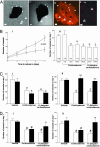Preventing local regeneration of glucocorticoids by 11beta-hydroxysteroid dehydrogenase type 1 enhances angiogenesis
- PMID: 16093320
- PMCID: PMC1189304
- DOI: 10.1073/pnas.0500641102
Preventing local regeneration of glucocorticoids by 11beta-hydroxysteroid dehydrogenase type 1 enhances angiogenesis
Abstract
Angiogenesis restores blood flow to healing tissues, a process that is inhibited by high doses of glucocorticoids. However, the role of endogenous glucocorticoids and the potential for antiglucocorticoid therapy to enhance angiogenesis is unknown. Using in vitro and in vivo models of angiogenesis in mice, we examined effects of (i) endogenous glucocorticoids, (ii) blocking endogenous glucocorticoid action with the glucocorticoid receptor antagonist RU38486, and (iii) abolishing local regeneration of glucocorticoids by the enzyme 11beta-hydroxysteroid dehydrogenase type 1 (11betaHSD1). Glucocorticoids, administered at physiological concentrations, inhibited angiogenesis in an in vitro aortic ring model and in vivo in polyurethane sponges implanted s.c. RU38486-enhanced angiogenesis in s.c. sponges, in healing surgical wounds, and in the myocardium of mice 7 days after myocardial infarction induced by coronary artery ligation. 11betaHSD1 knockout mice showed enhanced angiogenesis in vitro and in vivo within sponges, wounds, and infarcted myocardium. Endogenous glucocorticoids, including those generated locally by 11betaHSD1, exert tonic inhibition of angiogenesis. Inhibition of 11betaHSD1 in liver and adipose has been advocated to reduce cardiovascular risk in the metabolic syndrome: these data suggest that 11betaHSD1 inhibition offers a previously uncharacterized therapeutic approach to improve healing of ischemic or injured tissue.
Figures



References
-
- Kurotobi, T., Sato, H., Kinjo, K., Nakatani, D., Mizuno, H., Shimizu, M., Imai, K., Hirayama, A., Kodama, K. & Hori, M. (2004) J. Am. Coll. Cardiol. 44, 28-34. - PubMed
-
- Vernieri, F., Pasqualetti, P., Matteis, M., Passarelli, F., Troisi, E., Rossini, P. M., Caltagirone, C. & Silvestrini, M. (2001) Stroke 32, 1552-1558. - PubMed
-
- Hasan, Q., Tan, S. T., Gush, J., Peters, S. G. & Davis, P. F. (2000) Pediatrics 105, 117-120. - PubMed
-
- Aiello, L. P. & Wong, J. S. (2000) Kidney Int. Suppl. 77, S113-S119. - PubMed
-
- Siemann, D. W., Chaplin, D. J. & Horsman, M. R. (2004) Cancer 100, 2491-2499. - PubMed
Publication types
MeSH terms
Substances
Grants and funding
LinkOut - more resources
Full Text Sources
Other Literature Sources
Medical
Molecular Biology Databases

